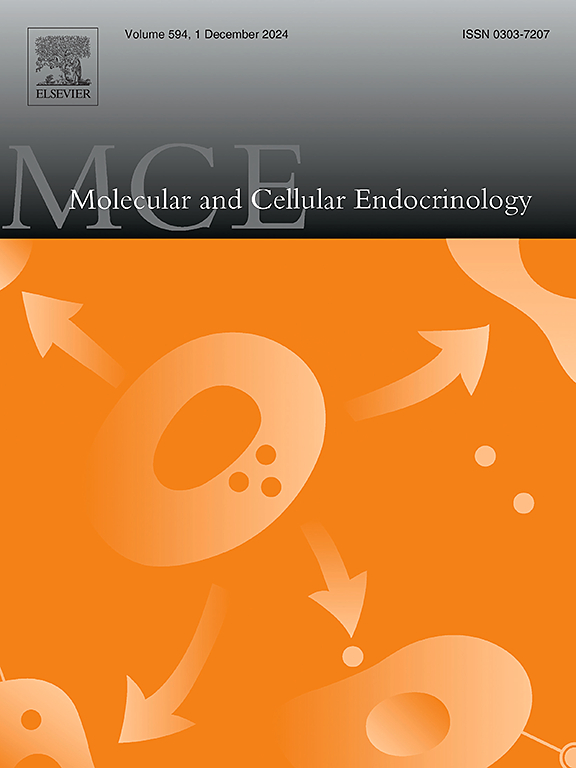醛固酮在女性激素缺乏所致内皮功能障碍中的作用
IF 3.6
3区 医学
Q2 CELL BIOLOGY
引用次数: 0
摘要
抑制肾素-血管紧张素系统可预防雌激素缺乏引起的大鼠血管功能障碍。然而,醛固酮在卵巢激素缺乏相关血管功能障碍中的作用尚不清楚。因此,我们旨在研究醛固酮通路在内源性女性激素缺乏模型中观察到的孤立阻力动脉和导管动脉内皮功能障碍中的作用。雌性Wistar大鼠(8周龄)接受双侧卵巢切除术(Ovx),随机分为每天服用螺内酯(Ovx Spi, 80 mg/kg)、安慰剂(Ovx)和假治疗螺内酯(Sham Spi, 80 mg/kg)或安慰剂(Sham组),为期60天。在分离的主动脉环,而不是肠系膜抵抗动脉,Ovx增加血管对苯肾上腺素的反应性,螺内酯可以阻止这种反应。L-NAME孵育提高了各组离体主动脉对苯肾上腺素的反应,但Ovx大鼠的影响较小。螺内酯可恢复Ovx大鼠的沉默反应。罗布麻素、过氧化氢酶、SOD、铁和ML-171均能减弱Ovx大鼠主动脉对苯肾上腺素的反应性,但螺内酯能阻止这种作用。螺内酯可以抑制Ovx大鼠主动脉一氧化氮的减少,以及超氧阴离子、过氧化氢、NOX4和NOX2蛋白表达的增加。因此,通过增加一氧化氮的生物利用度和减少NADPH氧化酶衍生的ROS的产生,螺旋内酯治疗可以预防Ovx大鼠主动脉内皮功能障碍,提示该途径在雌性激素缺乏大鼠血管功能障碍中发挥潜在作用。本文章由计算机程序翻译,如有差异,请以英文原文为准。

The role of aldosterone on the endothelial dysfunction induced by female hormone deficiency
Inhibition of the renin-angiotensin system prevents vascular dysfunction induced by estrogen deficiency in rats. However, the role of aldosterone in ovarian hormone deficiency-related vascular dysfunction is unclear. Therefore, we aimed to investigate the role of the aldosterone pathway in the endothelial dysfunction observed in isolated resistance and conduit arteries in a model of endogenous female hormone deficiency. Female Wistar rats (8 weeks old) underwent bilateral ovariectomy (Ovx) and were randomly assigned to receive daily treatment with spironolactone (Ovx Spi, 80 mg/kg), placebo (Ovx) and Sham treatment with spironolactone (Sham Spi, 80 mg/kg) or placebo (Sham group) for 60 days. In isolated aortic rings, but not mesenteric resistance arteries, Ovx increased vascular reactivity to phenylephrine that was prevented by spironolactone. Incubation with L-NAME increased the phenylephrine response in the isolated aorta in all groups, but this effect was smaller in Ovx rats. The muted response in the Ovx rats was restored by spironolactone. Apocynin, catalase, SOD, tiron and ML-171 attenuated the vascular reactivity to phenylephrine in the aorta of Ovx rats, but this effect was prevented by spironolactone. Corroborating these findings, the reduction of nitric oxide, and the increases in superoxide anion, hydrogen peroxide, NOX4 and NOX2 protein expression in aorta of Ovx rats were prevented by spironolactone. Therefore, spironolactone treatment prevented endothelial dysfunction in aorta from Ovx rats by increasing nitric oxide bioavailability and reducing NADPH oxidase-derived ROS production, suggesting a potential role of the pathway in the vascular dysfunction produced by female hormone deficiency in rats.
求助全文
通过发布文献求助,成功后即可免费获取论文全文。
去求助
来源期刊

Molecular and Cellular Endocrinology
医学-内分泌学与代谢
CiteScore
9.00
自引率
2.40%
发文量
174
审稿时长
42 days
期刊介绍:
Molecular and Cellular Endocrinology was established in 1974 to meet the demand for integrated publication on all aspects related to the genetic and biochemical effects, synthesis and secretions of extracellular signals (hormones, neurotransmitters, etc.) and to the understanding of cellular regulatory mechanisms involved in hormonal control.
 求助内容:
求助内容: 应助结果提醒方式:
应助结果提醒方式:


